Synthesis and Optical Characterizations of Yb3+: CaxSr1−xF2 Transparent Ceramics
Abstract
1. Introduction
2. Experimental Procedure
3. Results and Discussion
4. Conclusions
Author Contributions
Funding
Conflicts of Interest
References
- Hatch, S.E.; Parsons, W.F.; Weagley, R.J. Hot pressed polycrystalline CaF2: Dy ceramic lasers. Appl. Phys. Lett. 1964, 5, 153–154. [Google Scholar] [CrossRef]
- Srivastava, R.; Lauer, H.; Chase, L.; Bron, W. Raman frequencies of fluorite crystals. Phys. Lett. 1971, 36A, 333–334. [Google Scholar] [CrossRef]
- Rubloff, G.W. Far-ultraviolet reflectance spectra and the electronic structure of ionic crystals. Phys. Rev. 1972, B5, 662–684. [Google Scholar] [CrossRef]
- Lyberis, A.; Patriarche, G.; Gredin, P.; Vivien, D.; Mortier, M. Origin of light scattering in ytterbium doped calcium fluoride transparent ceramic for high power lasers. J. Eur. Ceram. Soc. 2011, 31, 1619–1630. [Google Scholar] [CrossRef]
- Wang, Y.; Wang, S.; Wang, J.; Zhang, Z.; Zhang, Z.; Liu, R.; Zu, Y.; Liu, J.; Su, L. High-efficiency ∼2 µm CW laser operation of LD-pumped Tm3+: CaF2 single-crystal fibers. Opt. Expreess 2020, 28, 6684–6695. [Google Scholar] [CrossRef]
- Jinge, L.; Ya, W.; Shuo, L.; Liangyu, G.; Chunting, W.; Yongji, Y.; Chao, W.; Guangyong, J. Study on LD end-pumped multi-segment bonded Tm: YAG solid-state laser. Opt. Commun. 2021, 480, 126452. [Google Scholar] [CrossRef]
- Basiev, T.T.; Doroshenko, M.E.; Konyushkin, V.A.; Osiko, V.V. SrF2: Nd3+ laser fluoride ceramics. Opt Lett. 2010, 35, 4009–4011. [Google Scholar] [CrossRef] [PubMed]
- Alimov, O.K.; Basiev, T.T.; Doroshenko, M.E.; Fedorow, P.P.; Konyushkin, V.A.; Nakladov, A.N.; Osiko, V.V. Investigation of Nd3+ ions spectroscopic and laser properties in SrF2 fluoride single crystal. Opt Mater. 2012, 34, 799–802. [Google Scholar] [CrossRef]
- Samuel, P.; Ishizawa, H.; Ezura, Y.; Ueda, K.I.; Babu, S.M. Spectroscopic analysis of Eu doped transparent CaF2 ceramics at different concentration. Opt. Mater. 2011, 33, 735–737. [Google Scholar] [CrossRef]
- Fan, J.; Chen, S.; Yuan, X.; Jiang, Y.; Pan, L.; Jiang, B.; Mao, X.; Li, R.; Jiang, X.; Zhang, L. Recrystallization of Er3+: CaF2 in Transparent Fluorophosphate Glass-Ceramics with the Co-Firing Method. J. Am. Ceram. Soc. 2016, 99, 2971–2976. [Google Scholar] [CrossRef]
- Zhou, Z.W.; Li, W.W.; Song, J.H.; Yi, G.; Mei, B.; Su, L. Synthesis and characterization of Nd3+ doped SrF2 nanoparticles prepared by precipitation method. Ceram. Int. 2018, 44, 4344–4350. [Google Scholar] [CrossRef]
- Lu, X.; Jiang, B.; Li, J.; Liu, W.; Wang, L.; Ba, X.; Hu, C.; Liu, B.; Pan, Y. Synthesis of highly sinterable Yb: Sc2O3 nanopowders for transparent ceramic. Ceram. Int. 2013, 39, 4695–4700. [Google Scholar] [CrossRef]
- Zhang, L.; Pan, W.; Feng, J. Dependence of spectroscopic and thermal properties on concentration and temperature for Yb: Y2O3 transparent ceramics. J. Eur. Ceram. Soc. 2015, 35, 2547–2554. [Google Scholar] [CrossRef]
- Takaichi, K.; Yagi, H.; Shirakawa, A.; Ueda, K.; Hosokawa, S.; Yanagitani, T.; Kaminskii, A.A. Lu2O3:Yb3+ ceramics-a novel gain material for high-power solid-state lasers. Phys. Status. Solidi A 2005, 202, 1–3. [Google Scholar] [CrossRef]
- Lucca, A.; Jacquemet, M.; Druon, F.; Balembois, F.; Georges, P.; Camy, P.; Doualan, J.L.; Moncorgé, R. High-power tunable diode-pumped Yb3+: CaF2 laser. Opt. Lett. 2004, 29, 1879–1881. [Google Scholar] [CrossRef]
- Lucca, A.; Debourg, G.; Jacquemet, M.; Druon, F.; Balembois, F.; Georges, P.; Camy, P.; Doualan, J.L.; Moncorgé, R. High-power diode-pumped Yb3+: CaF2 femtosecond laser. Opt. Lett. 2004, 29, 2767–2769. [Google Scholar] [CrossRef]
- Petit, V.; Camy, P.; Doualan, J.-L. Spectroscopy of Yb3+: CaF2: From isolated centers to clusters. Phys. Rev. B. 2008, 78, 085131. [Google Scholar] [CrossRef]
- Wu, Y.; Zou, Z.; Wang, C.; Liu, J.; Zheng, L.; Su, L. Broadly tunable and passively mode-locked operations of Yb3+, Gd3+: SrF2 Laser. IEEE J. Sel. Top. Quant. 2019, 25, 1100405. [Google Scholar] [CrossRef]
- Jiang, Y.G.; Wang, Z.Y.; Zhang, L.F.; Yuan, C.; Zhang, L. Transparent Nd, Y- Codoped Ca1−xSrxF2 glass-ceramic with large emission bandwidth tailored by a controllable spontaneous precipitation under supersaturated state. Ceram. Int. 2019, 45, 24651–24655. [Google Scholar] [CrossRef]
- Veselský, K.; Šulc, J.; Jelínková, H.; E Doroshenko, M.; A Konyushkin, V.; Nakladov, A.N. Spectroscopic and laser properties of a broadly tunable diode-pumped Tm3+: CaF2-SrF2 laser. Laser Phys. Lett. 2020, 17, 025802. [Google Scholar] [CrossRef]
- Tian, X.Q.; Ma, F.K.; Zhang, Z. Linear correlation of crystal structure and spectral properties of Nd3+ in Ca1−xSrxF2 mixed crystals. J. Am. Ceram. Soc. 2020, 103, 3650–3656. [Google Scholar] [CrossRef]
- Basiev, T.T.; Doroshenko, M.E.; Fedorov, P.P.; Konyushkin, V.A.; Kuznetsov, S.; Osiko, V.V.; Akchurin, M.S. Efficient laser based on CaF2-SrF2-YbF3 nanoceramics. Opt. Lett. 2008, 33, 521–523. [Google Scholar] [CrossRef] [PubMed]
- Zhu, C.; Song, J.; Mei, B.; Li, W.; Liu, Z. Fabrication and optical characterizations of CaF2-SrF2-NdF3 transparent ceramic. Mater. Lett. 2016, 167, 115–117. [Google Scholar] [CrossRef]
- Zhou, Z.; Mei, B.; Song, J.; Li, W.; Yang, Y.; Yi, G. Effects of Sr2+ content on microstructure and spectroscopic properties of Nd3+ doped Ca1−xSrxF2 transparent ceramics. J. Alloy Compd. 2019, 811, 152046. [Google Scholar] [CrossRef]
- Hume-Rothery, W. Comments on papers resulting from Hume-Rothery´s Note-1965. Acta Metall. 1967, 15, 567–569. [Google Scholar] [CrossRef]
- Wan, Z.; Li, W.; Mei, B.; Liu, Z.; Yang, Y. Fabrication and spectral properties of Ho-doped calcium fluoride transparent ceramics. J. Lumin. 2020, 223, 117188. [Google Scholar] [CrossRef]
- Xiong, F.; Song, J.; Li, W.; Mei, B.; Su, L. Influence of sintering conditions on the microstructure and optical properties of Eu: CaF2 transparent ceramic. Mater. Res. Bull. 2017, 95, 138–145. [Google Scholar] [CrossRef]
- Ikesue, A.; Yoshida, K.; Yamamoto, T.; Yamaga, I. Optical scattering centers in polycrystalline Nd: YAG laser. J. Am. Ceram. Soc. 1997, 80, 1517–1522. [Google Scholar] [CrossRef]
- Aidilibike, T.; Guo, J.; Li, Y.; Liu, X.; Qin, W. Triplet cooperative luminescence of Yb3+-doped AF2 (A=Ca, Sr) crystals. J. Lumin. 2017, 188, 107–111. [Google Scholar] [CrossRef]
- Youngman, R.E.; Smith, C.M. Multinuclear NMR studies of mixed Ca1−xSrxF2 crystals. Phys. Rev. B 2008, 78, 014112. [Google Scholar] [CrossRef]
- Vegard, L. Die konstitution der mischkristalle und die raumfellung der atome. Z. Phys. 1921, 5, 17–26. [Google Scholar] [CrossRef]
- Lyberis, A.; Stevenson, A.J.; Suganuma, A.; Ricaud, S.; Druon, F.; Herbst, F.; Vivien, D.; Gredin, P.; Mortier, M. Effect of Yb3+ concentration on optical properties of Yb: CaF2 transparent ceramics. Opt. Mater. 2012, 34, 965–968. [Google Scholar] [CrossRef]
- Gao, Y.W.; Mei, B.C.; Li, W.W.; Zhou, Z.; Liu, Z. Effect of Yb3+ concentration on microstructure and optical properties of Yb: SrF2 transparent ceramics. Opt. Mater. 2020, 105, 109869. [Google Scholar] [CrossRef]
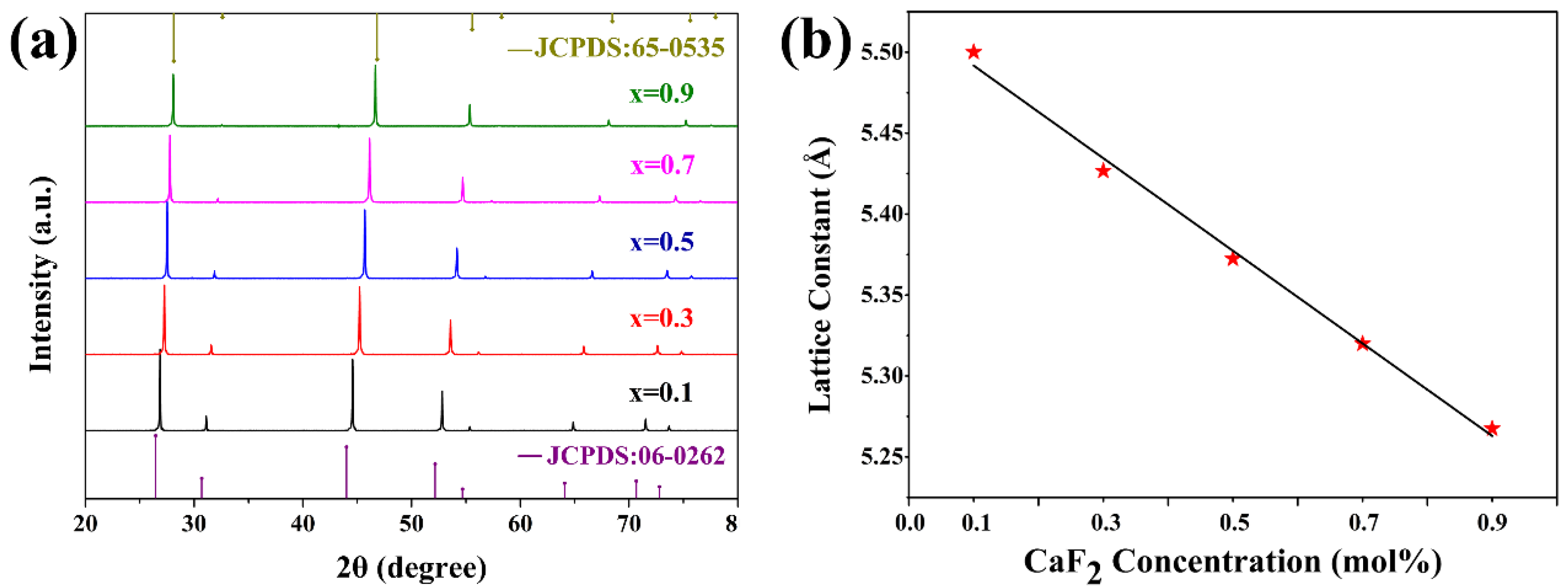
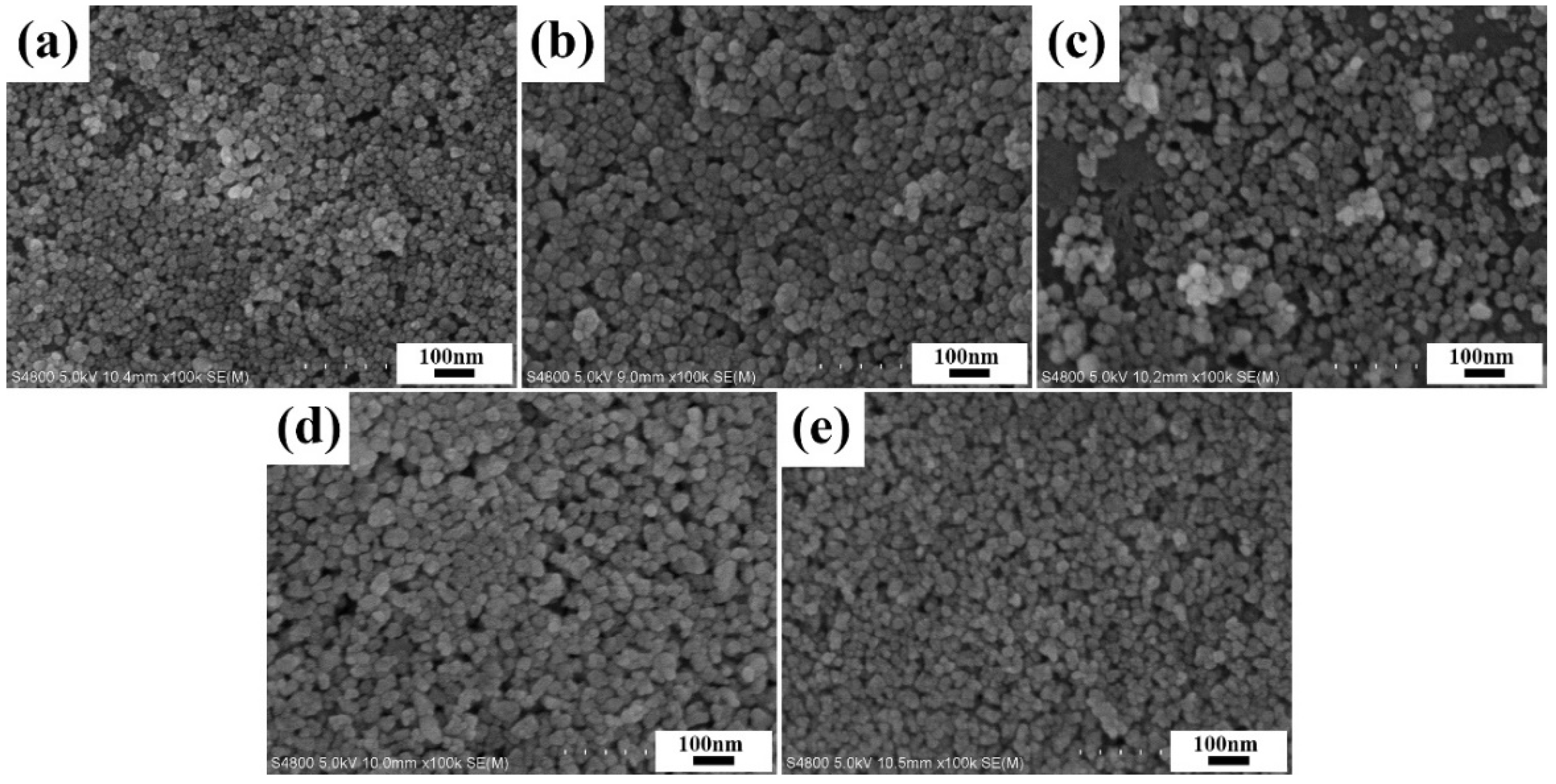
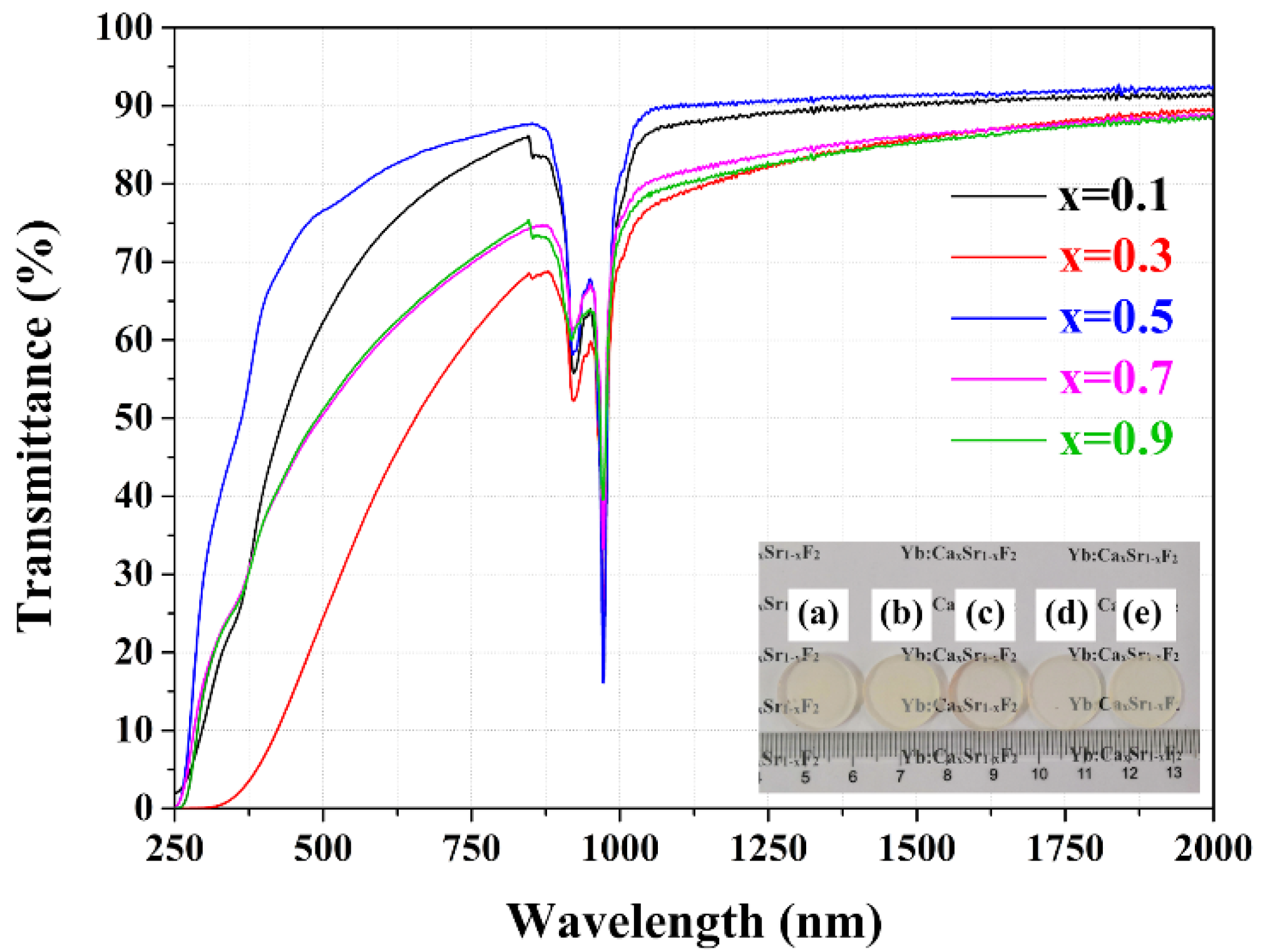
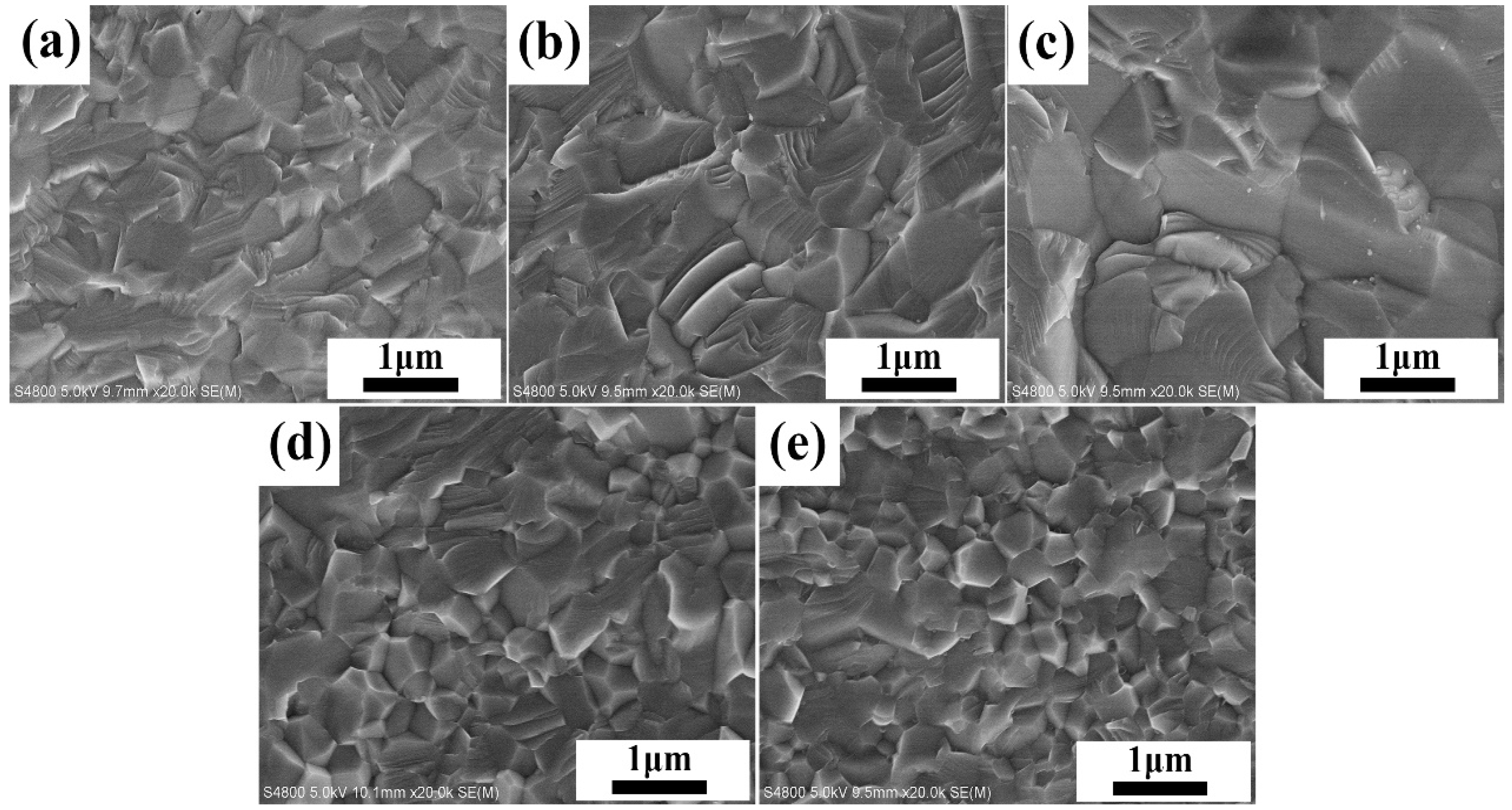
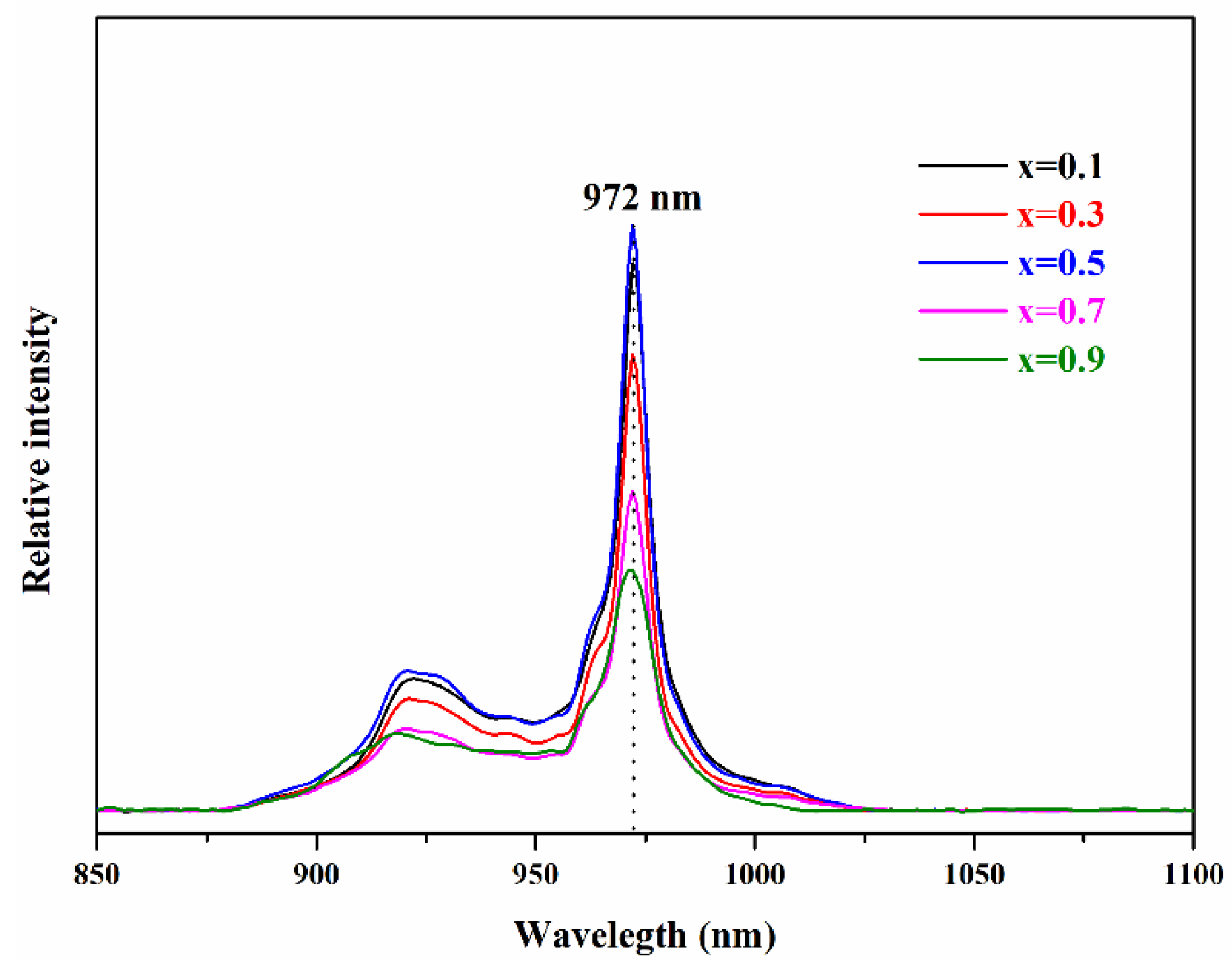
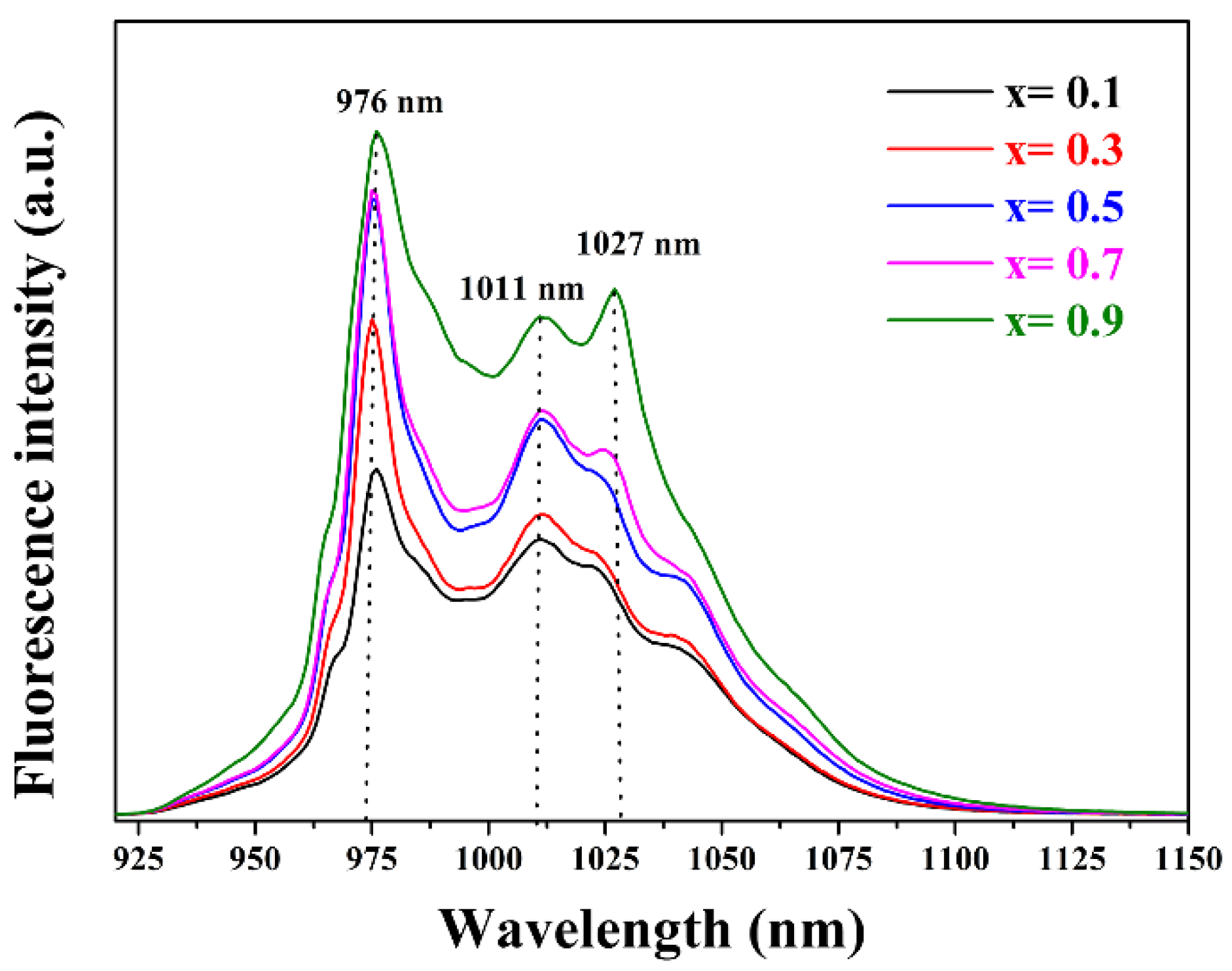


| Sample | Yb3+ (mol%) | |
|---|---|---|
| Designed Value | ICP Result (±0.01) | |
| 3 at.% Yb: Ca0.1Sr0.9F2 | 3 | 2.82 |
| 3 at.% Yb: Ca0.3Sr0.7F2 | 3 | 2.67 |
| 3 at.% Yb: Ca0.5Sr0.5F2 | 3 | 2.84 |
| 3 at.% Yb: Ca0.7Sr0.3F2 | 3 | 2.63 |
| 3 at.% Yb: Ca0.9Sr0.1F2 | 3 | 2.60 |
Publisher’s Note: MDPI stays neutral with regard to jurisdictional claims in published maps and institutional affiliations. |
© 2021 by the authors. Licensee MDPI, Basel, Switzerland. This article is an open access article distributed under the terms and conditions of the Creative Commons Attribution (CC BY) license (https://creativecommons.org/licenses/by/4.0/).
Share and Cite
Ling, H.; Mei, B.; Li, W.; Yang, Y.; Zhang, Y.; Liu, X. Synthesis and Optical Characterizations of Yb3+: CaxSr1−xF2 Transparent Ceramics. Crystals 2021, 11, 652. https://doi.org/10.3390/cryst11060652
Ling H, Mei B, Li W, Yang Y, Zhang Y, Liu X. Synthesis and Optical Characterizations of Yb3+: CaxSr1−xF2 Transparent Ceramics. Crystals. 2021; 11(6):652. https://doi.org/10.3390/cryst11060652
Chicago/Turabian StyleLing, Hongran, Bingchu Mei, Weiwei Li, Yu Yang, Yongqiang Zhang, and Xinwen Liu. 2021. "Synthesis and Optical Characterizations of Yb3+: CaxSr1−xF2 Transparent Ceramics" Crystals 11, no. 6: 652. https://doi.org/10.3390/cryst11060652
APA StyleLing, H., Mei, B., Li, W., Yang, Y., Zhang, Y., & Liu, X. (2021). Synthesis and Optical Characterizations of Yb3+: CaxSr1−xF2 Transparent Ceramics. Crystals, 11(6), 652. https://doi.org/10.3390/cryst11060652





